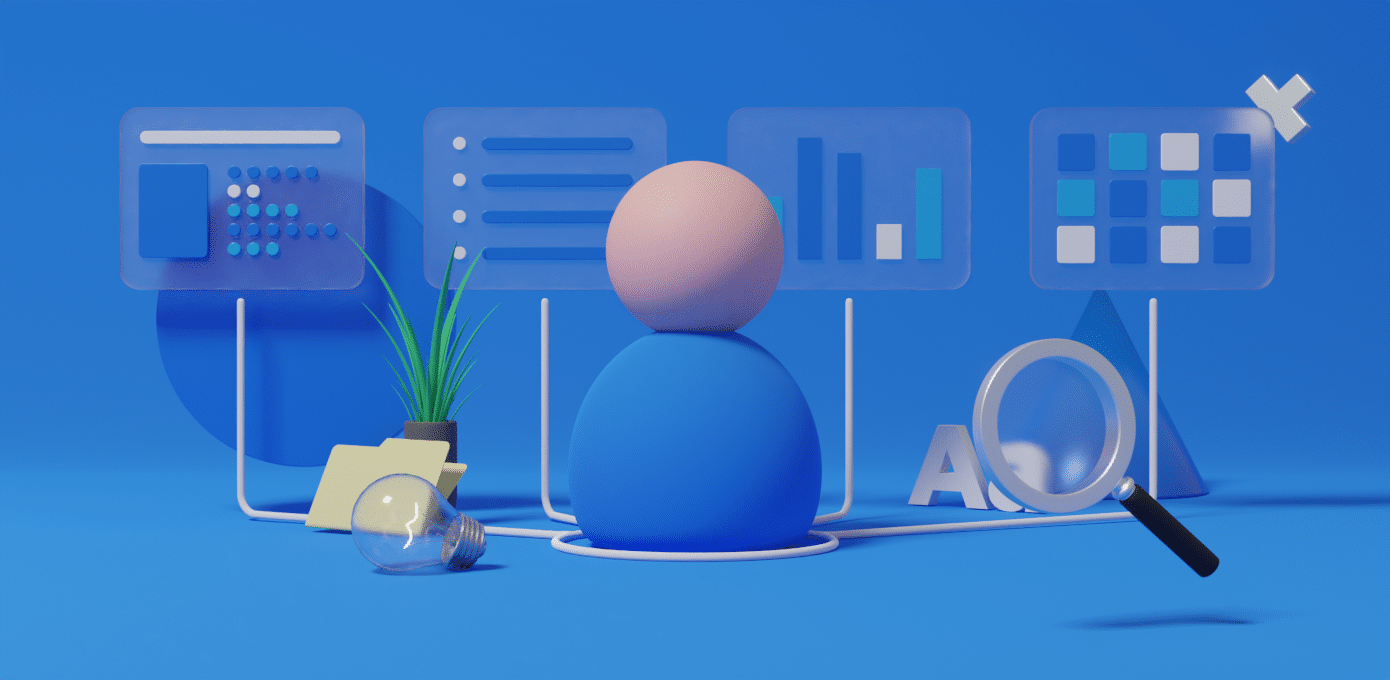Creating a robust and detailed buyer persona for your B2B business is a critical activity you must undertake if you haven't already. Selling in a B2B setting is tricky since the target company’s decision-makers, meaning your potential customers, are weighing your product or service against your competitors on their own terms.
Yes, your product might have unique characteristics and your company—a pristine reputation, but that in itself is not enough to secure profitable deals. You must persuade your prospects, and you need to know exactly who they are.
And no, it’s not enough to just identify key individuals within a particular company. You must know them inside-out to stand the best chances in nurturing leads into profitable contracts.
44% of B2B marketers are already reaping the revenue benefits thanks to the well-developed buyer personas.
Thus, if you don't want to be late to the bandwagon, keep reading this article where we cover everything about B2B buyer personas, including the step-by-step process for creating one.
On top of that, we'll provide you with a free buyer persona template that will allow you to determine key decision-makers in your target organizations.
So, without further ado, let’s jump right in.
What Is a Buyer Persona?
A buyer persona, also known as a customer persona, is not just another marketing buzzword—it’s a multidimensional profile of somebody within your target audience. More precisely, it’s a semi-fictional and highly detailed portrayal of a person who will most likely benefit from your solution.
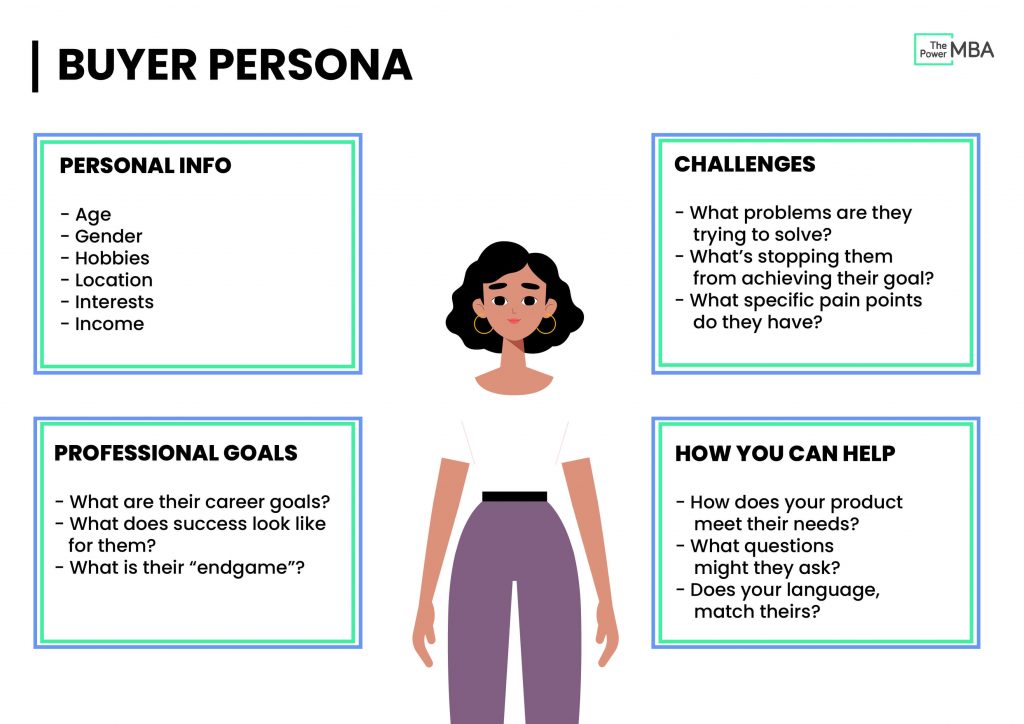
Source: www.thepowermba.com
A solid buyer persona comprises a thorough grasp of your customer's demographics, habits, attitudes, behaviors, motivations, concerns, and pain points—all of which help develop nuanced marketing tactics and continuous development of your product.
What's the Difference between Buyer Personas, ICP, and Your Target Audiences?
When it comes to effective marketing strategies, it all boils down to three types of customer characteristics: buyer personas, ideal customer profiles (ICP), and target audience. They all help you segment your customers, but they do so slightly differently.
An ideal customer profile (ICP) defines a hypothetical organization that possesses all of the characteristics that would make it the perfect fit for your business’s products or services. It encompasses details, such as firmographics, including industry, location, budget, company size, and shared pain points. These predefined characteristics allow you to accurately qualify leads and ensure that your sales team targets only those accounts that are the right fit.
On the other hand, a buyer persona is an individual within your ideal target organization who has decision-making power and can purchase your product or service. Unlike the ICP, the emphasis is on a person’s specific character attributes and habits rather than a business. They’re essentially the people your sales reps will be talking to directly.
Finally, the target audience is a broader definition of a particular group your solution is targeting. These people might want your product, but we don’t know all the ins and outs of these individuals—they simply share similar demographics. For example, HR managers aged 35-50, residents of London, with yearly income ranging from £60,000 to £120,000, and work at mid-sized to large enterprises.
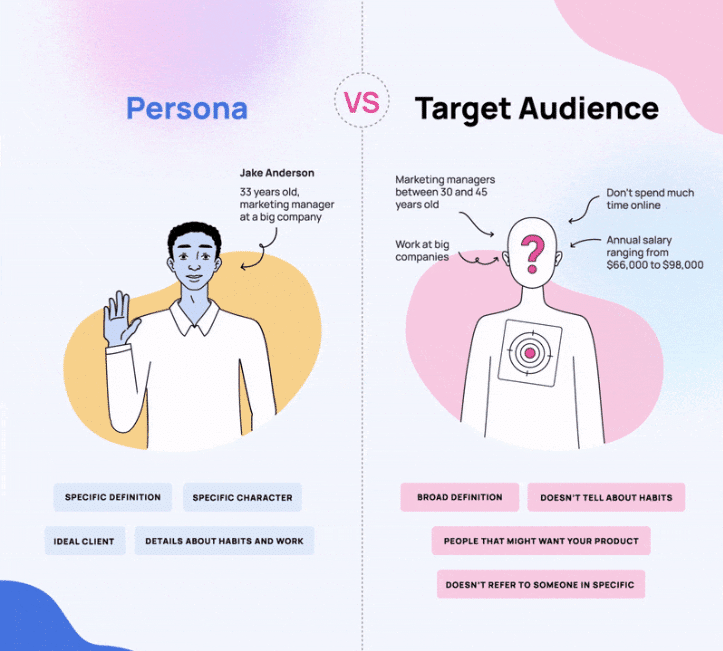
Source: rockcontent.com
What's a Negative Buyer Persona?
As vital as it is to establish your ideal consumers, you must also identify the red flags. A negative buyer persona encompasses a collection of demographics, behaviors, and habits that disqualify leads as unfit for your offering.
Let’s say you only want to target sales and marketing representatives in a company with over 100 employees, but the only leads you get from your marketing efforts are from start-ups or people working in accounting or HR. Of course, it’s nice to get to talk to companies in general and promoting your product, but it’s a waste of time if not any of these companies sign a deal in the end.
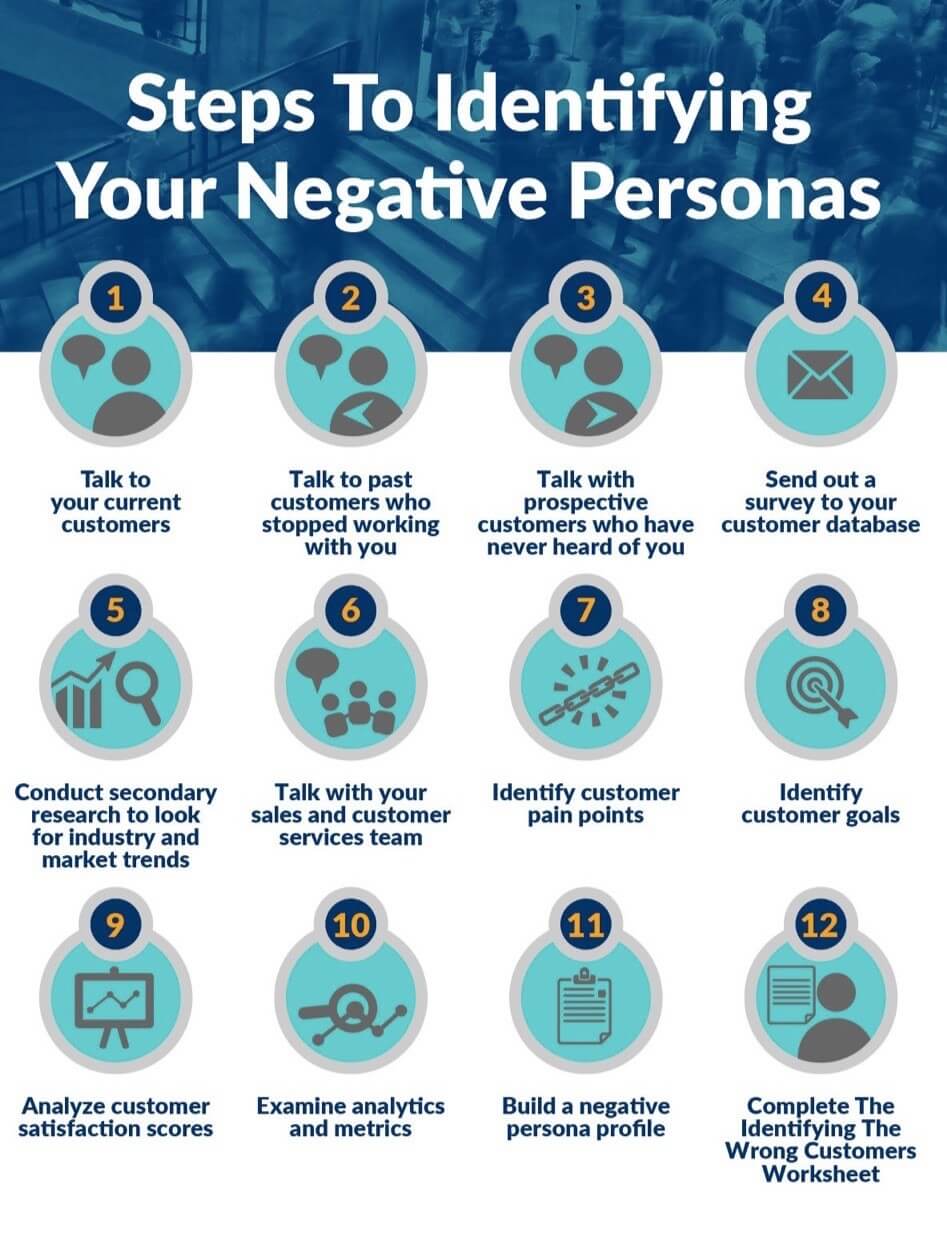
Source: www.10forward.ae
Why Do We Need Buyer Personas, Especially in B2B?
B2B buyer personas play an essential part in refining your ideal customers and allowing marketing and sales teams to focus their efforts on targeting accounts that stand the best chance of converting.
So, why do we need such personas, and how can we use them?
1. They Help You Understand Your Customers
Defining a B2B buyer persona profile equals thorough research. Unlike B2C buyer personas, where the main focus is on the demographics, B2B counterparts include specific triggers, such as challenges, business objectives, and inefficiencies.
Whether you decide to look through contact databases, create surveys, or conduct interviews with customers or prospects, you will be left with a wealth of raw data to develop your ideal buyer persona.
Likewise, getting into the nitty-gritty of your potential customers means that your company can truly learn about their challenges and goals, which ultimately helps to target marketing campaigns appropriately.
2. In-detail Buyer Profile Allows You to Hone Your Marketing Tactics
Before making a purchase decision, B2B buyers typically consume 13 pieces of content. Doesn't it seem like a lot? Most of these content interactions could be attributed to long sales cycles; however, it’s all about your precision-targeted messaging and personalization.
Executives, unsurprisingly, are wary of organizations who send out generic content en mass. However, a buyer persona makes it easier to tailor the messages, the content, and the preferred channel, so it hits a sweet spot right away.
3. Enable You to Map Out the Buyer’s Journey and Target Content
Awareness, consideration, and decision are three main stages in a buyer's journey. Depending on where your B2B prospect is, they will have different questions about your product.
Hence, creating a buyer profile and linking it to these different stages allows you to develop a content strategy that directly addresses customers’ questions, pushes them further down the marketing funnel, and encourages a high level of interaction and robust opportunities to convert.
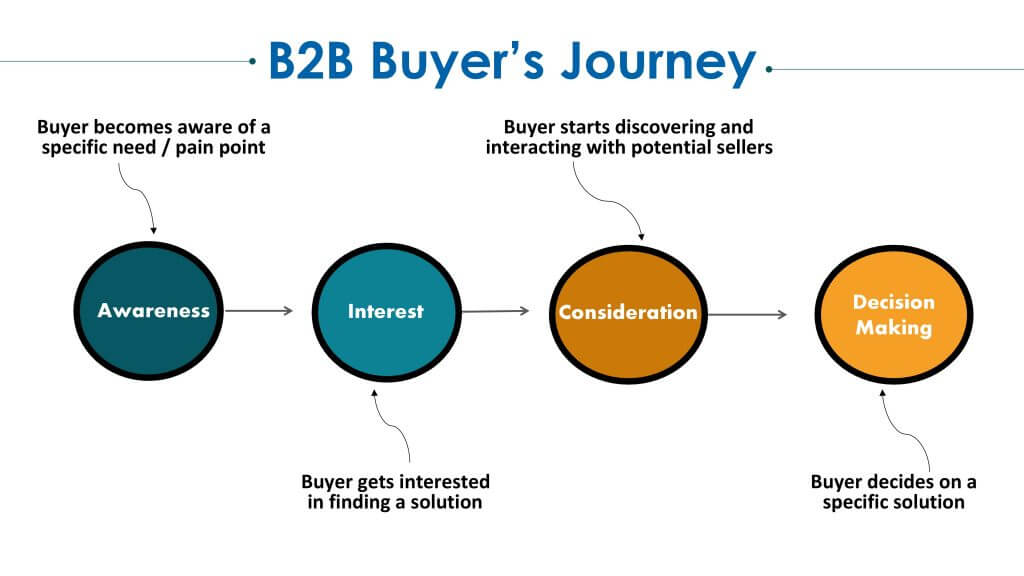
Source: mindpooltech.com
4. Achieve Higher Lead Conversion
Buyer personas equip your business with precise insights into your customers' wants and needs, vastly improving your lead conversion process.
Failure to create solid buyer personas can result in low conversion rates, as the product, marketing, and sales decisions will be based on poor insights and therefore are too generic to convince your dream customer.
5. They Guide the Decisions on the Creation of New Products and Services
Defining a buyer persona is not a typical done and dusted exercise—they must be regularly updated to reflect ever-changing customer needs and modifications or changes in your products.
Up-to-date buyer personas allow you to finetune your company’s offerings to serve your customers better and outrun your competitors.
How to Create Your Buyer Persona in B2B in 6 Steps
So, how do you get started with creating B2B buyer personas? Follow these simple steps and utilize your data as a primary source of information to guide the process.
Step 1: Start with Buyer Persona Research
The creation of a buyer persona relies heavily on research. You want to dig deep to understand what makes your B2B customers tick. These are some approaches you can use to extract real insights:
- Current customer questionnaires;
- Client interviews;
- Focus groups;
- Scouring of social media channels;
- Utilization of your CRM and ABM platforms.
Step 2: Leverage Contact Data Using Sales Intelligence Tools
Sales intelligence tools, such as Dealfront, can help you scout and provide B2B contact data to people in organizations. Dealfront’s powerful filters allow you to search for key decision-makers within your ideal company, in any department, on different hierarchy levels, or with specific job titles.
Dealfront’s unique crawler feature facilitates the creation of your buyer persona as it gathers, sorts, and analyzes all the information that your target customer has ever made public, going as far as picking up on the sales triggers. Hence, you know precisely your prospects’ interests and pain points.
Equipped with such accurate information, you can build a solid buyer persona, get straight to the key decision-makers within your target company and make deals at scale!
Step 3: Determine the Customer’s Goals and Pain Points
Thanks to Dealfront, half of the job on this front is already done. But since you’re already talking to your customers and prospects (remember, the interviews and surveys we mentioned earlier), you might want to delve deeper and extract more nuanced data about their concerns.
Are they using a solution that is already a pain point because it's too costly or ineffective? Are their processes too cumbersome, and are they looking to streamline them? Ambitions to expand into overseas markets, but no effective CRM solution to manage foreign accounts? Whatever these inefficiencies are, make sure you capture and analyze them before drawing up your buyer personas.
Step 4: Understand How Your Business Solves Your Customers’ Problems
Now that you have heard your customers’ side, think about how your product solves their problems. Dive beyond the features of your solution. Think about its value and the actual impact on making your B2B customer’s life easier. Summarize your unique selling point in one crispy clean sentence and use it in your marketing comms.
Step 5: Bring Your Personas to Life
Time to compile your B2B buyer persona(s) by writing everything you discovered about them during your primary research:
- How old is your buyer persona?
- What is their job title?
- Is your buyer persona a key decision-maker?
- What is their highest level of education?
- Where are they based?
- What are their career or company-focused goals?
- What areas of work are they struggling with and want to improve?
- What do they do in their spare time?
These questions will allow you to understand the particular profile of your key customer segments and fuel your marketing and sales efforts.
Tip: Don’t forget to give your buyer persona a name and an avatar—visualizations make them feel like a real person.
Step 6: Share Your Buyer Persona with the Entire Team
Is your product missing something that your target audience desires? Has your landing page’s conversion rate been stagnating for a while? Are your sales reps failing to close high-ticket deals? Don’t ask these questions—put your B2B buyer persona in front of every department.
Familiarize your sales, marketing, and product teams with your buyer personas, so that they can start speaking to your audience in their language. It’s essential on every level of your business that everybody in your company understands how your ideal customers make decisions, what content they read, and what product features appeal to them the most.
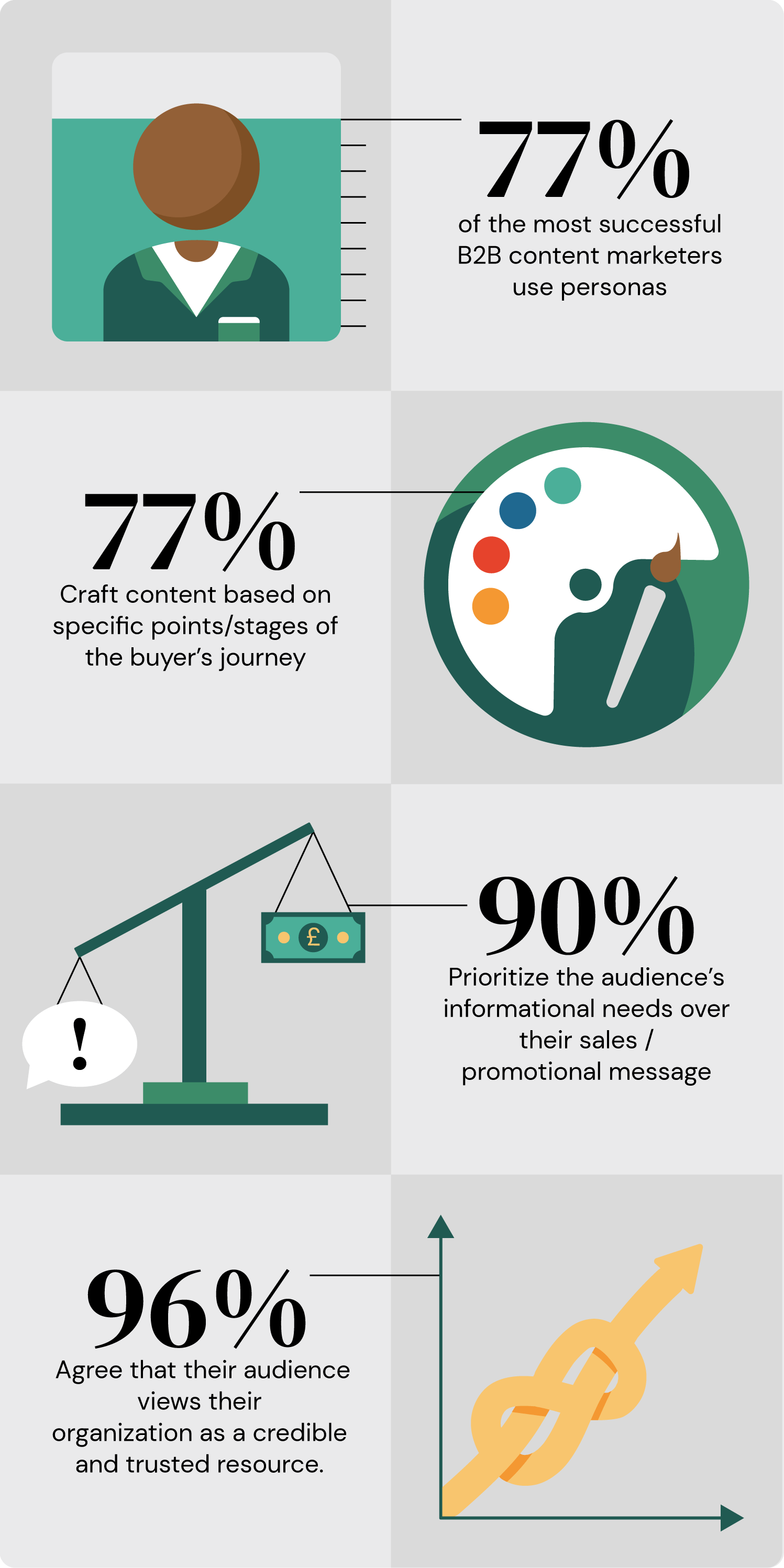
Source: www.wigwam.digital
How Many Buyer Personas Should I Have?
There is no set amount of buyer personas that you should define—be realistic, and ensure that they are based on achievable objectives. Having too many personas could mean that you have to balance too diverging types of prospects, too few—and you may miss out on the one and only who will convert.
Research shows that over 90% of business sales are generated by 3 to 4 buyer personas, so starting with this number is recommended.
Example of a Buyer Persona (HR Software Provider)
Now that we’ve covered the theory, here is a practical example of a B2B buyer persona.
Let’s pretend you’re an HR software business pushing the sales of your automated CV screening solution. Jordan is your buyer persona with the following characteristics:
Name: Jordan.
Age: 43.
A Purchase Decision-Maker: Yes.
Location: Frankfurt, Germany.
Position: Senior Recruitment Manager at a large retail business.
Background: Jordan is married and has two children. He is originally from London but relocated to Frankfurt 4 years ago to work as a recruitment manager. He was promoted to his present job after the senior recruitment manager resigned. His highest qualification to date is a master’s degree in Human Resources Management.
Goals: Jordan wishes to create a more robust recruitment process to meet seasonal demand in his retail business.
Pain Points: Jordan realized his company struggles to compete for local talent during peak seasons, such as Christmas and summer. Due to the high volume of job applications and lengthy manual CV screening, the company loses workers to competitors. Consequently, the retailer cannot meet customer demand, negatively affecting revenue.
Preferred Channels for Content Consumption: Jordan has been considering HR automation. He enjoys reading HR software reviews and case studies to understand the actual benefits of such systems.
How Can We Help Jordan: Your sales team has identified that your CV screening automation software could best address Jordan’s challenges. The marketing team has prepared a product specification sheet and customer success stories to demonstrate how our solution helped similar businesses.
Conclusion: Buyer Personas Help You Understand Who You're Dealing With
Don’t take B2B Buyer Personas lightly—they are your source of information to drive your venture forward and go after the right customers for your business.
Buyer profiles help you understand who you’re dealing with, where to focus your time, and how to finetune your marketing message and guide your sales department. Buyer personas represent individuals within your target companies; thus, you must know what appeals to them and what you can do to entice them.
Perfecting your buyer personas will synchronize your product, sales, marketing, and customer service teams, enhancing your capacity to win right-fit clients and close profitable deals.
Download: Your Free B2B Buyer Persona Template
Ready to start building your buyer personas right now? Then use our free buyer persona template and see what characteristics you mustn't miss out!
